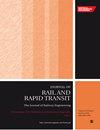基于熵权 TOPSIS 的城市轨道交通车辆牵引特性评价研究
IF 2.1
4区 工程技术
Q3 ENGINEERING, CIVIL
Proceedings of the Institution of Mechanical Engineers Part F-Journal of Rail and Rapid Transit
Pub Date : 2024-07-22
DOI:10.1177/09544097241250370
引用次数: 0
摘要
本文旨在研究牵引特性曲线(TCC)恒功率段末端不同速度对车辆动态性能的影响,并对 TCC 进行评估。本文使用 SIMPACK 和 MATLAB 开发了一个动力学协同仿真模型,用于对不同牵引特性下的城轨车辆(URV)进行动力学分析。然后,利用该模型研究了在不同启动扭矩下,加速距离和车辆动态性能如何随 TCC 恒功率段末端速度的变化而变化。此外,还选择了广泛用于解决多目标决策问题的熵权 TOPSIS 方法,根据 25 个测试路段和加速距离的各种动态性能指标对牵引特性进行评价。结果表明,在牵引条件下,起动转矩对车体横向和纵向加速度、车轮与钢轨的横向和纵向接触力、脱轨系数和车轮卸载系数都有影响。扭矩越大,各项指标值越大,即车辆行驶特性和运行安全性越差。对于给定的起始扭矩,在车辆加速过程中,随着恒定功率段末端速度从 50 km/h 提高到 80 km/h,动态性能指标也随之提高。当恒定动力段末端速度从 50 km/h 增加到 80 km/h 时,车身横向和纵向加速度、车轮与导轨的横向和纵向接触力的最大增长率分别为 17%、8%、8% 和 2%。最后,利用熵权 TOPSIS 法对牵引特性进行综合评价,发现当起始扭矩为 800[计算公式:见正文]、1000[计算公式:见正文]、1200[计算公式:见正文]和 1400[计算公式:见正文]时,相应的恒功率段末端最佳速度分别为 80 km/h、80 km/h、70 km/h 和 50 km/h。研究结果可为城市轻轨车辆的牵引特性设计和牵引控制提供理论支持。本文章由计算机程序翻译,如有差异,请以英文原文为准。
Research on the traction characteristic evaluation of urban rail vehicles based on entropy weight TOPSIS
This paper aims to investigate the influence of different speed at the end of the constant power section of the traction characteristic curve (TCC) on the vehicle dynamic performance and evaluate the TCC. A dynamics co-simulation model is developed in SIMPACK and MATLAB for dynamic analysis of the urban rail vehicle (URV) under different traction characteristics. Then it is used to investigate how acceleration distance and vehicle dynamic performance varies with the speed at the end of the constant power section of the TCC under different starting torques. Moreover, the entropy weight TOPSIS method which is widely used to solve the multi-objective decision-making problem is chosen to evaluate the traction characteristics based on various dynamic performance indexes over 25 test sections and acceleration distance. The results show that under traction conditions, the starting torque has effects on the lateral and vertical accelerations of car body, lateral and vertical wheel-rail contact forces, derailment coefficient and wheel unloading factor. The higher the torque, the greater the value of each index, that means the poorer the vehicle ride characteristics and running safety. For a given starting torque, the dynamic performance indexes increase with the increase of the speed at the end of the constant power section from 50 km/h to 80 km/h during the vehicle speed-up process. The maximum growth rate of the lateral and vertical accelerations of car body, lateral and vertical wheel-rail contact forces are 17%, 8%, 8% and 2%, respectively, when the speed at the end of the constant power section increases from 50 km/h to 80 km/h. Last, the comprehensive evaluation of traction characteristics using entropy-weight TOPSIS method reveals when the starting torque is 800 [Formula: see text], 1000 [Formula: see text], 1200 [Formula: see text] and 1400 [Formula: see text], the corresponding optimal speed at the end of the constant power section is 80 km/h, 80 km/h, 70 km/h and 50 km/h, respectively. The result of the study can provide theoretical support for traction characteristic design and traction control for URVs.
求助全文
通过发布文献求助,成功后即可免费获取论文全文。
去求助
来源期刊

CiteScore
4.80
自引率
10.00%
发文量
91
审稿时长
7 months
期刊介绍:
The Journal of Rail and Rapid Transit is devoted to engineering in its widest interpretation applicable to rail and rapid transit. The Journal aims to promote sharing of technical knowledge, ideas and experience between engineers and researchers working in the railway field.
 求助内容:
求助内容: 应助结果提醒方式:
应助结果提醒方式:


